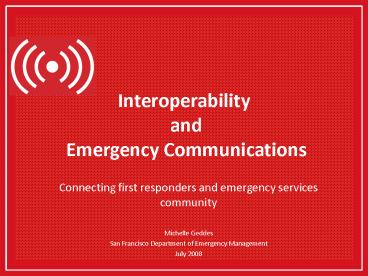Interoperability and Emergency Communications - PowerPoint PPT Presentation
1 / 22
Title:
Interoperability and Emergency Communications
Description:
when they need it. The radio they use every day will become the ... California Highway Patrol. Golden Gate Bridge District. Presidio Fire. SFFD Fire and EMS ... – PowerPoint PPT presentation
Number of Views:39
Avg rating:3.0/5.0
Title: Interoperability and Emergency Communications
1
Interoperability and Emergency Communications
- Connecting first responders and emergency
services community - Michelle Geddes
- San Francisco Department of Emergency Management
- July 2008
2
Interoperability
- Ensures First Responders can talk
- to who they need to,
- wherever they are,
- when they need it.
The radio they use every day will become the
radio they use everywhere
3
Emergency Voice Communications
- Voice Communications is
- Push-to-Talk (PTT) Radio
- Dedicated for Public Safety Usage
- 100 Reliability, with no delay and no down time
- 100 Availability Region-wide coverage
including in building and underground - Interoperability with all disciplines
4
Emergency Data Communications
5
Agenda Overview
- The Need for Interoperability
- Interoperability Challenges
- Emergency Communications Trends
- Interoperability Solutions
6
Interoperability The Need
Mass Terrorism
Fire Storm
Rare
Mass Evacuation
School Shooting
Earthquake
Airplane Crash
Occasional
Increasing Criticality of Interoperability
Frequency of Activity
Crime Spree Investigation
Multiple Alarm Fire
Common
Industrial Hazmat
Police Chase
Daily
2 3 4 5 6 50
Number of Responding Agencies
6
7
Interoperability The Need
- 1989 - Loma Prieta Earthquake
- 1991 - Oakland Hills Firestorm
- March 26th2008 Golden Gate Bridge Multi-injury
Accident
- Responding agencies were
- Marin Fire and EMS
- California Highway Patrol
- Golden Gate Bridge District
- Presidio Fire
- SFFD Fire and EMS
Not one agency uses the same radio system,
complicating communications
8
Agenda Overview
- The Need for Interoperability
- Interoperability Challenges
- Emergency Communications Trends
- Interoperability Solutions
9
Interoperability Challenges
- Governance
- Funding
- Spectrum Availability
- Incompatible Technologies
- Willingness to change and proper training
10
Governance
- Establishing a Joint Powers Agreement (JPA)
between jurisdictions, cities, counties and
agencies - -OR-
- Developing Memorandum of Understanding (MOU)
- Agreeing to Standard Operating Procedures (SOPs)
and Guidelines for System Usage and Sharing - Determining Maintenance Agreements and
Sustainable Funding Mechanism
11
Funding
- Sustained funding sources are typically not
available to state and local agencies - Designing and implementing a public safety grade
network can be cost prohibitive - Fault tolerance, with no single point of failure
- 100 Coverage Requirements
- Backup Power
12
Spectrum Availability
Federal Communications Commission (FCC)State and
Local Public Safety Communications Spectrum
Availability
National Telecommunications and Information
Administration (NTIA) Coordinates Spectrum for
all Federal Agencies
13
Technology Incompatibilities
- Manufacturers have not had to standardize on one
technology platform, creating networks that are
incompatible
EF JOHNSON
KENWOOD
VOTING
VIOP
PROJECT 25
3600 BAUD
ICOM
MOTOROLA
SIMULCAST
9600 BAUD
THALES
CONVENTIONAL
EADS
ANALOG
DIGITAL
TRUNKING
TRANSMITTER STEERING
14
Bay Area System Usage
Due to a lack of coordinated planning Spectrum
availability is sparse and inconsistent,
rendering radios useless out of a home coverage
area. Systems were built by multiple
manufacturers, with incompatible technologies.
15
Agenda Overview
- The Need for Interoperability
- Interoperability Challenges
- Emergency Communications Trends
- Interoperability Solutions
16
Emergency Communications Trends
- Trend 1 - Regional Interoperability and Network
Sharing - Trend 2 - Multi- Discipline Collaboration
- Trend 3 Movement towards standards-based
systems - Trend 4 Convergence of Voice and Data Networks
17
Converged Voice and Data Network
Internet
NOC
E911/ 311 Dispatch Sites
Other Agency P25 Networks/ IP backbones
P25 ISSI
Public VoIP or PSTN
Legacy LMRGateway(s)
IP PBX
IP Backbone
Network IP Gateway
Legacy LMR
IMS Gateway
PSTN
Public Cellular
Commercial Broadband
ASTRO 25 SecureIP Backbone
Govt P25/Tetra LMR
Government Wideband/ BB
MWNE
Interoperability Seamless Mobility between user
agencies, access networks, and devices
LMR
802
Cell
Satellite
P25oIP PTx Applications
18
Agenda Overview
- The Need for Interoperability
- Interoperability Challenges
- Emergency Communications Trends
- Interoperability Solutions
19
Safecom ProgramDepartment of Homeland Security
20
700MHz Spectrum Beachfront Property
FCC released 700MHz of Spectrum for First
Responders, Available Feb. 2009 FCC Auctioning
20MHz of Broadband Spectrum for a Public/Private
Partnership
21
BayRICS Program Overview
- Announced by Mayors Newsom, Dellums, and Reed on
September 11, 2007 - Collaboration with all 10 Bay Area Counties
- Multi-discipline participation including
- Law Enforcement
- Fire
- Emergency Services
- Emergency Medical Service
- Public Health
- Transit Agencies
- Critical Infrastructure Entities (Schools, Ports,
Bridges)
Bay Area Super UASI Region
Implementation Stages Planning Stages
The Interoperability Goal is to connect the Bay
Area Region by 2012
22
Conclusion / Lessons Learned
- Create a formal Governance structure, that
includes all levels of government and disciplines
- Develop a sustained funding mechanism
- Create standards and network performance
requirements to ensure technology
interoperability - Continue development SOPs and training to ensure
beneficial use of the system































